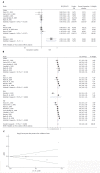Compared efficacy of preservation solutions on the outcome of liver transplantation: Meta-analysis
- PMID: 29713134
- PMCID: PMC5922999
- DOI: 10.3748/wjg.v24.i16.1812
Compared efficacy of preservation solutions on the outcome of liver transplantation: Meta-analysis
Abstract
Aim: To compare the effects of the four most commonly used preservation solutions on the outcome of liver transplantations.
Methods: A systematic literature search was performed using MEDLINE, Scopus, EMBASE and the Cochrane Library databases up to January 31st, 2017. The inclusion criteria were comparative, randomized controlled trials (RCTs) for deceased donor liver (DDL) allografts with adult and pediatric donors using the gold standard University of Wisconsin (UW) solution or histidine-tryptophan-ketoglutarate (HTK), Celsior (CS) and Institut Georges Lopez (IGL-1) solutions. Fifteen RCTs (1830 livers) were included; the primary outcomes were primary non-function (PNF) and one-year post-transplant graft survival (OGS-1).
Results: All trials were homogenous with respect to donor and recipient characteristics. There was no statistical difference in the incidence of PNF with the use of UW, HTK, CS and IGL-1 (RR = 0.02, 95%CI: 0.01-0.03, P = 0.356). Comparing OGS-1 also failed to reveal any difference between UW, HTK, CS and IGL-1 (RR = 0.80, 95%CI: 0.80-0.80, P = 0.369). Two trials demonstrated higher PNF levels for UW in comparison with the HTK group, and individual studies described higher rates of biliary complications where HTK and CS were used compared to the UW and IGL-1 solutions. However, the meta-analysis of the data did not prove a statistically significant difference: the UW, CS, HTK and IGL-1 solutions were associated with nearly equivalent outcomes.
Conclusion: Alternative solutions for UW yield the same degree of safety and effectiveness for the preservation of DDLs, but further well-designed clinical trials are warranted.
Keywords: Liver transplantation; Meta-analysis; One-year post-transplant graft survival; Preservation solution; Primary non-function; Systematic review.
Conflict of interest statement
Conflict-of-interest statement: None of the authors has any conflict of interests related to this manuscript.
Figures



Similar articles
-
Histidine-tryptophan-ketoglutarate solution vs. University of Wisconsin solution for liver transplantation: a systematic review.Liver Transpl. 2007 Aug;13(8):1125-36. doi: 10.1002/lt.21208. Liver Transpl. 2007. PMID: 17665493
-
Preservation solutions for liver transplantation in adults: celsior versus custodiol: a systematic review and meta-analysis with an indirect comparison of randomized trials.Transplant Proc. 2013 Jan-Feb;45(1):25-32. doi: 10.1016/j.transproceed.2012.02.031. Epub 2012 Sep 15. Transplant Proc. 2013. PMID: 23267794
-
A systematic review and meta-analysis of cold in situ perfusion and preservation of the hepatic allograft: Working toward a unified approach.Liver Transpl. 2017 Dec;23(12):1615-1627. doi: 10.1002/lt.24829. Epub 2017 Nov 8. Liver Transpl. 2017. PMID: 28734125 Free PMC article.
-
Systematic review of preservation solutions for allografts for liver transplantation based on a network meta-analysis.Int J Surg. 2018 Jun;54(Pt A):1-6. doi: 10.1016/j.ijsu.2018.04.024. Epub 2018 Apr 21. Int J Surg. 2018. PMID: 29684666
-
Three Preservation Solutions for Cold Storage of Heart Allografts: A Systematic Review and Meta-Analysis.Artif Organs. 2016 May;40(5):489-96. doi: 10.1111/aor.12585. Epub 2015 Nov 2. Artif Organs. 2016. PMID: 26526678
Cited by
-
Comparative study between fructose 1-6 bisphosphate and histidine-tryptophan-ketoglutarate in liver preservation in rats submitted to total cold ischemia.Acta Cir Bras. 2020;35(6):e202000603. doi: 10.1590/s0102-865020200060000003. Epub 2020 Jul 8. Acta Cir Bras. 2020. PMID: 32667586 Free PMC article.
-
A Potential Route to Reduce Ischemia/Reperfusion Injury in Organ Preservation.Cells. 2022 Sep 5;11(17):2763. doi: 10.3390/cells11172763. Cells. 2022. PMID: 36078175 Free PMC article. Review.
-
Clinical Outcomes of Transplanted Kidneys from Deceased Donors Using Different Generic Preservation Solutions.Medicina (Kaunas). 2022 Nov 2;58(11):1579. doi: 10.3390/medicina58111579. Medicina (Kaunas). 2022. PMID: 36363536 Free PMC article.
-
Liver preservation prior to transplantation: Past, present, and future.World J Gastrointest Surg. 2019 Mar 27;11(3):122-125. doi: 10.4240/wjgs.v11.i3.122. World J Gastrointest Surg. 2019. PMID: 31057697 Free PMC article.
-
Application of ischaemia-free liver transplantation improves prognosis of patients with steatotic donor livers - a retrospective study.Transpl Int. 2021 Jul;34(7):1261-1270. doi: 10.1111/tri.13828. Epub 2021 Jun 7. Transpl Int. 2021. PMID: 33484201 Free PMC article.
References
-
- Jia JJ, Li JH, Jiang L, Lin BY, Wang L, Su R, Zhou L, Zheng SS. Liver protection strategies in liver transplantation. Hepatobiliary Pancreat Dis Int. 2015;14:34–42. - PubMed
-
- Brisson H, Arbelot C, Monsel A, Parisot C, Girard M, Savier E, Vezinet C, Lu Q, Vaillant JC, Golmard JL, et al. Impact of graft preservation solutions for liver transplantation on early cytokine release and postoperative organ dysfunctions. A pilot study. Clin Res Hepatol Gastroenterol. 2017;41:564–574. - PubMed
-
- Stewart ZA. UW solution: still the “gold standard” for liver transplantation. Am J Transplant. 2015;15:295–296. - PubMed
-
- Sanchez-Urdazpal L, Gores GJ, Ward EM, Maus TP, Wahlstrom HE, Moore SB, Wiesner RH, Krom RA. Ischemic-type biliary complications after orthotopic liver transplantation. Hepatology. 1992;16:49–53. - PubMed
-
- Cutrin JC, Cantino D, Biasi F, Chiarpotto E, Salizzoni M, Andorno E, Massano G, Lanfranco G, Rizzetto M, Boveris A, et al. Reperfusion damage to the bile canaliculi in transplanted human liver. Hepatology. 1996;24:1053–1057. - PubMed
Publication types
MeSH terms
Substances
LinkOut - more resources
Full Text Sources
Other Literature Sources
Medical
Research Materials
Miscellaneous

